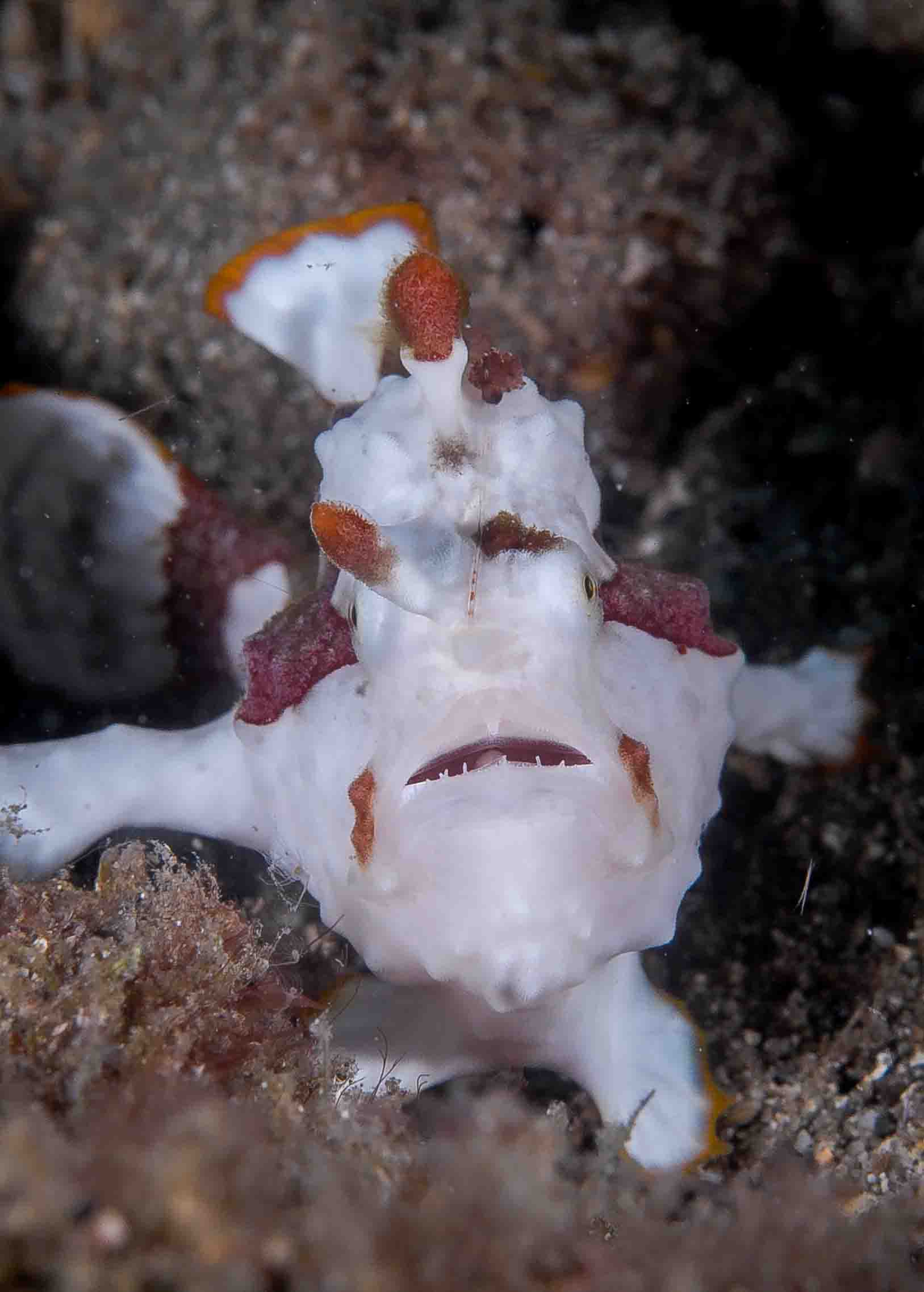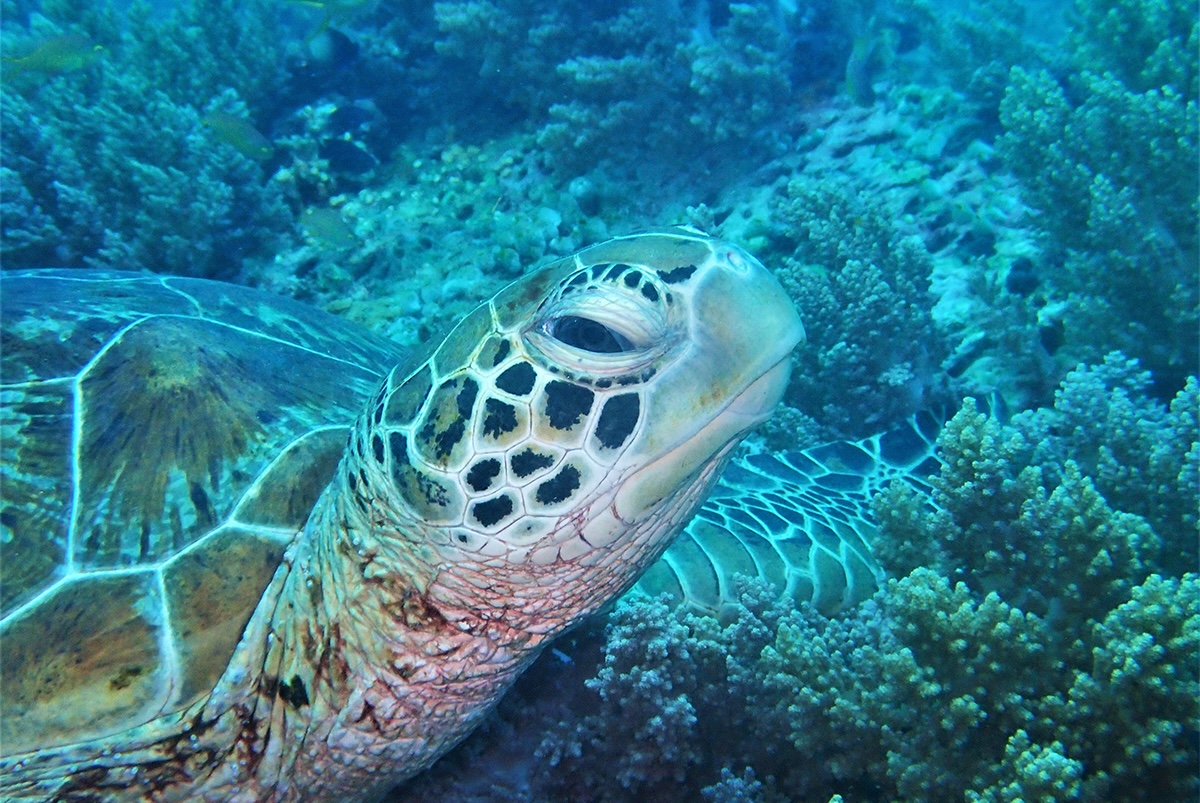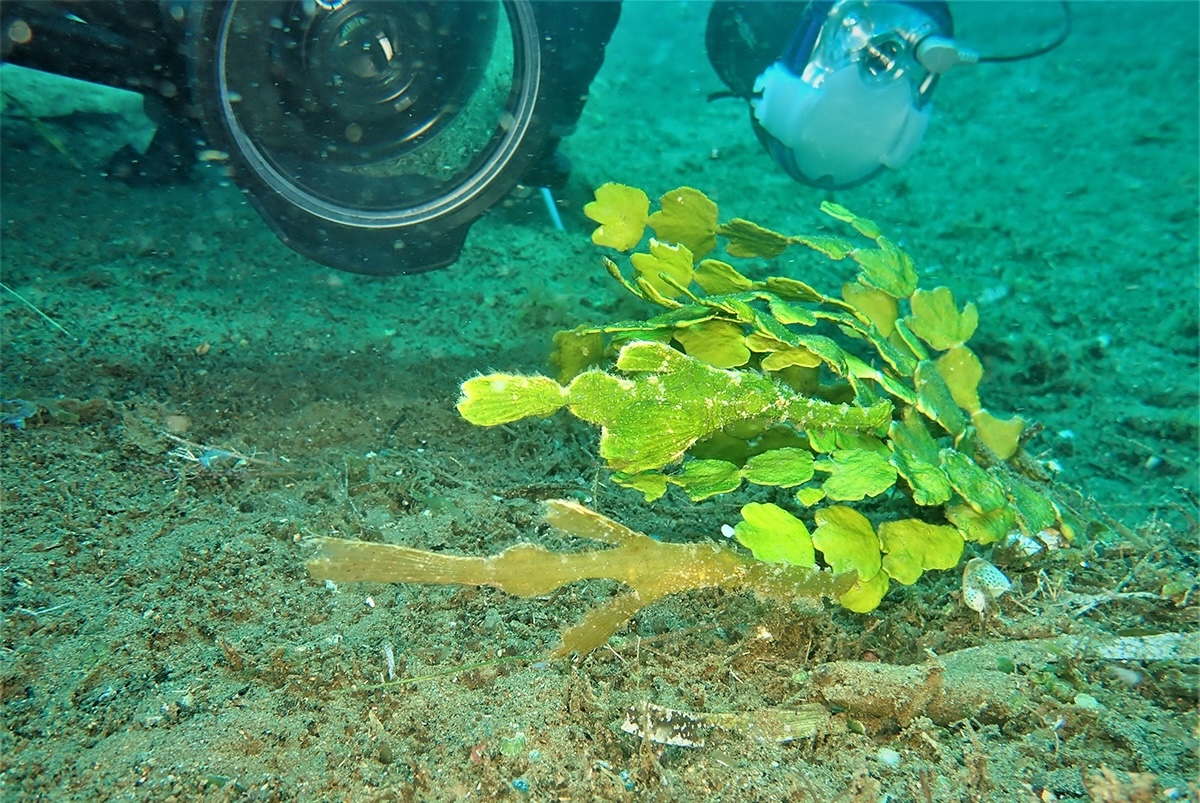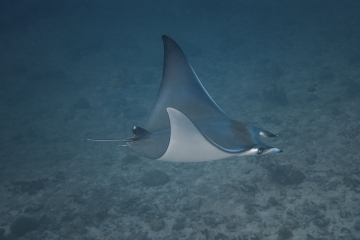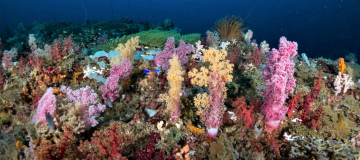Diving trips and liveaboard in the Philippines
The Philippines is actually larger than Sweden with the sea included (smaller landmass), lies east of the Asian continent and consists of roughly 7 islands. In what is often referred to and often referred to as the Coral Triangle, the diving is exciting and very varied. Also on land, there are huge cultural and linguistic differences. Even nature is very varied. If you want to go on a really good diving trip and experience as much as possible of the best diving in the Philippines, you should go on a liveaboard. You can then experience several different marine species and environments. You can do diving trips and liveaboard in the Philippines all year round. However, some parts of the Philippines will be unavailable during parts of the year.
Many dive sites in the Philippines are easily accessible from land. It makes that liveaboard has not become as popular here as in for example Indonesia. A big advantage of going on diving trips and a liveaboard in the Philippines the first time or times is that you get a greater variety. You will get to see more places and experience more diving in a shorter time. After doing one or a couple of different diving cruises in the Philippines, you will have found your favorite diving spots. Then you will be able to plan new trips and more specifically know where you want to go again and maybe have that as a base to then combine with something new and still be sure that you get something you really like. The Philippines can be traveled to many many times and get to dive and experience widely different environments and types of diving.
The Philippines can be a diving trip all year round
At the time of writing there are only a few few liveaboards in the Philippines. Some are really good and some are let's say of debatable level and quality. All these liveaboards move around the country depending on the time of year. The Philippines is often exposed to really rough weather and can vary a lot from day to day. It is possible to dive and experience the Philippines all year round, but some dive sites and parts of the country are only accessible for a short time of the year.
There are currently three parts of the Philippines that offer liveaboards. Visayas in the middle of the country with the islands of Negros, Cebu, Bohol and Leyte. The elongated island to the west called Palawan and the capricious Sulu Sea. As well as another part of what is called Mimaropa with diving in the Sibuyan Sea. The area is accessed via the strait at Masbate, Ticao in the east, Verde Island in the west near famous dive sites such as Anilao and Puerto Galera and Tablas / Romblon in the south.
Diving trips and liveaboard to Tubbataha Reef in the Philippines
In the middle of the Sulu Sea lies a fantastic creation - Tubbataha reefs. Today classified as a UNESCO World Heritage Site and protected marine park. The reef consists of three atolls and here you can see about 90% of all coral species (about 360 different) found in the Philippines. The reefs and the sea make up an area of almost 100 hectares and are an important place for turtles and various bird species to breed. There are at least eleven different species of whales and dolphins and at least eleven species of sharks. In addition, there are also over 000 species of fish documented. This is one of the few places in the world where you can actually be lucky enough to see six or seven different species of shark during a single dive. It is also known to have the world's highest density of whitetip reef sharks.
The Sulu Sea is a sea that is heavily influenced by the forces of the weather. It is only for a few months each year that it is possible to go on a diving trip and liveaboard here. Between March and June, the sea is usually so calm that all liveaboarders gather here to be able to offer you and others the fantastic diving that is available in the area. The sea is surrounded by the islands of Palawan to the west, Borneo to the south, Mindanao, Negros and Panay to the east and Mindoro to the north. You should book well in advance to have a chance to dive at Tubbataha reefs. The few liveaboards that go here that are of good or safe quality are often booked at least a couple of years in advance. Sometimes even longer.
Long journey here and book in time
Most often, groups and diving tour operators book the whole boat several years in advance, but there can occasionally be leftover spots on a boat. As it is often larger groups that book the entire or almost the entire liveaboard, there is a risk that you will end up outside of a large group. It can be quite boring sometimes when you are completely outside and don't understand what is being said. It may also happen that they plan things that you don't want to do as well. The trip here departs from the city of Puerto Princesa in Palawan and you have to fly here from either Manila or Cebu.
To get here you will need at least one night stopover in one of these cities. You should also have at least one night in Puerto Princesa before going with the liveaboard. IF the luggage is scattered on the road, it's no fun. The boat then out to Tubbata reef takes about ten hours and the journey out there takes the boat overnight. The next morning you wake up in the middle of the Sulu Sea and at one of the world's most powerful diving sites.
Sharks sharks sharks
When you get all the way here after a rather long journey, you will quickly discover that it was worth the journey. At the spectacular reefs you have fantastic visibility and plenty of fish. Steep coral walls that plunge down to depths of several hundred meters. They are covered in various corals and sponges. You will see large shoals of fish and lots of sharks. Up on the top reef, the light plays and the fish make the reef come alive. White tip reef shark and gray reef shark are almost 13 out of the dozen. Here you usually see huge shoals of barracuda or tuna. The dives are enlivened by passing pelagic giants such as hammerhead sharks, tiger sharks, thresher sharks, whale sharks, silvertips, nurse sharks, eagle rays, manta rays and even sawfish and guitar sharks are occasionally seen.
If you want the most extreme and fantastic experience possible, you can go on a so-called transition trip. These are the tours that start or end the season in Tubbataha reefs. You will then be traveling from or to another location in the Philippines. As a rule north with Mindoro and Puerto Galera or east to Cebu. Maybe you pass by Apo reefs or Cagayancillo on the road. There you can get even more diving and get more variety during the trip. These tours usually last ten to fourteen days. Normally it is otherwise six to seven nights on board for diving trips and liveaboard to Tubbataha reef in the Philippines.
Liveaboard cruise in the Visayas
The islands of Negros, Cebu, Bohol and Leyte are the major and most famous parts of the Philippines and what makes up the Visayas. Diving is popular and a growing industry. Most famous are perhaps more specifically places like Malapascua, Moalboal, Mactan, Cabilao, Balicasag, Panglao and Alona Beach. Along with Dauin, Anda, Apo Island, Oslob and Camiguin Island, these are all places visited and appreciated by divers from all over the world. The Visayas in the central parts of the Philippines is a fantastic region with a huge variety of diving and very rich in marine life. What you can see is everything from tiny nudibranchs and crustaceans to real badasses like whale sharks, manta rays, dolphins and various species of shark. If you have the right tud, whales such as blue whales, killer whales and pilot whales can actually appear out at sea. Also hammerhead sharks and thresher sharks and more are seen here every now and then when the time is right.
Cebu - thresher sharks and sardines
Malapascua is a beautiful little island and well known as one of the best places in the world to see and dive with the beautiful but shy thresher shark. In English thresher shark, a very special shark that is seen sporadically in other places but precisely at Monad shoal it is seen almost daily. Early mornings rising at four o'clock and then diving to about 30 meters and waiting for them to appear. But there are other large animals such as manta rays and reef sharks which are common and also rays and tuna and to this an amazing macro life. Malapascua is a small island and very popular with divers. All liveaboarders who drive in the Visayas usually stay there for at least one day and especially to experience thresher sharks. During a couple of months there is also the possibility to occasionally dive with hammerhead sharks at Kimod shoal.
Moalboal further south on Cebu's west coast is one of the first major diving destinations in the Philippines. Everything from whale sharks, dolphins, manta rays, eagle rays to the giant shoals of sardines can be seen. At Pescador Island there are caves and dramatic wall dives with lots of fish. The diving in the entire area is classic wall diving and steep reef slopes. It is also slowly growing more and more black water diving up. Then you dive at night without references and pretty much hang on a line. Especially among photographers, this is very popular and it is 6-700 meters deep in the strait between Cebu and Negros.
Bohol Sea
Out on the east coast of Mactan Island outside Cebu City just a few kilometers from the international airport you can dive at surprisingly nice coral reefs and here is perfect for families to stay and several liveaboards start and stop. Outside the very beautiful island of Bohol, a little further south is the small island of Cabilao, which offers high-class wall diving and plenty of fish. There are also nice shallow bottoms suitable for beginners where you often see seahorses, frogfish and various nudibranchs.
A little further south is Alona beach on the small island of Panglao, which now has an international airport. The diving is great but it is probably the smaller islands of Balicasag and Pamilacan that have the best diving. However, it is an obvious stop on the road for a liveaboard in the Philippines in the Visayas. But that is IF there are places. Balicasag has a very limited number of divers per day and it must be booked in advance. You will find dramatic walls where there are often large shoals of tuna and plenty of turtles. There are also plenty of other fish and mostly reef sharks patrolling the walls.
A little further south is the small but beautiful island of Camiguin. Just north of the Philippines' second largest island, Mindanao, you have fantastic diving. It is unfortunately not visited very often but has really nice coral reefs and walls and a rich marine life. Here you almost always see dolphins on the surface and sometimes larger whales passing by. The Bohol Sea is actually one of the world's most whale-dense seas and there are at least 13 different species of whales including several species of dolphins identified. The reefs are buzzing with life and visibility is often very good.
Apo Island and Dauin
The small island of Apo Island is probably the most famous diving spot in the entire Visayas. It is located in Dauin and is known for its fine reefs, fantastic visibility and lots of turtles. Tourists from all over the world come here with boats from Dauin to snorkel and dive. You can see hammerhead sharks and thresher sharks, but good luck and fairly deep dives are required. It is usually in the morning that you can see them if you are lucky. Otherwise, the island is perfect for beginners who can see lots of fish and, as I said, often lots of turtles, and also for snorkelers.
The diving in Dauin is best known otherwise for the incredible macro life and critter diving. Dauin is today one of the most popular destinations for divers in the entire Philippines and diving tourism is growing steadily. When you go on a liveaboard here, you often stop and do one or two days max and if you're unlucky, you might not see very much. You have to get to one of the better places and they constantly change from week to week. A good day with a good dive is absolutely magical. You will always find and see funny animals but it is constantly changing. Otherwise, you will generally find different types of nudibranchs, crustaceans and often different seahorses and funny octopuses. Despite all the diving resorts and liveaboards, Dauin never feels crowded or touristy.
Whale sharks in Oslob and diving in Anda
Oslob which is located in the southern part of the island of Cebu and is probably at least as well known as Dauin. Here you are guaranteed to see and dive with whale sharks. To be blunt, it's very touristy and arranged!, bordering on the extreme actually and unfortunately. It is very organized and strict rules apply. You feed the whale sharks to make them come here and stay there for everyone to see. They are free to swim as they wish but they are in this particular area. On a good day for diving, there are maybe only 30-50 people on site. Both divers and snorkelers come every day. On other days, there can be up to 2-300 people at the same time. They come from resorts, liveaboard or from land with buses and cars.
The whale sharks are here and you can definitely dive or snorkel with them. For those of you who absolutely want to see a whale shark, this is a fun experience. Most liveaboarders stop for a dive and sometimes also at Sumilon Island right nearby which has plenty of reef sharks and nice wall dives. Here too, with a lot of luck, you can see hammerhead sharks.
Anda in eastern Bohol is probably less known in the Visayas but is occasionally visited by liveaboarders. On the southeast coast of the island of Bohol, there is very good diving. You can find species that are not found in many other places. Among other things, the small leopard shrimp that lives together with a special anemone. At the eastern part of the Bohol Sea, you can sometimes also see large animals such as whale sharks and blue whales passing by as well as dolphins. Turtles are seen frequently and are common and there are very beautiful coral reefs. Diving isn't that big yet, but it's coming.
Liveaboard in Sibuyan Sea
Recently, a new scheme for diving trips and liveaboarding in the Philippines appeared. It's a really exciting diving safari that starts in Anilao just a few hours from Manila and then goes through the Sibuyan Sea. You pass through the Verde Island passage and the diving here is claimed by some to be the best diving in the Philippines. I'm not inclined to agree but it's good. Verde Island is located in the strait between the main island of Luzon and Mindoro. The island is famous for diving around Puerto Galera and also for great species richness, lush corals and rich macro life. There are also some species of shark and often turtles, frogfish, ghost pipefish, octopuses and shoals of tuna and barracuda.
Then you travel further down towards the islands around Romblon, Masbate and Ticao and maybe even down to Southern Leyte and disembark in Surigao in northeastern Mindanao. Ticao pass is known for its rapid water and its large collections of manta rays. Some dives can be quite boring if the mantas are not around but if they are there it is great diving here and very memorable dives. There is also quite a lot of macro life to discover.
Romblon province - magical macro diving
A small province and archipelago in the Philippines is Romblon. It is located in the middle of Sibuyan sea and very close to the most famous tourist destination in the Philippines, Boracay. There is a treasure to discover here for those of you who like macro diving and especially nudibranchs or nudibranchs. You will find species of nudibranchs that you hardly see anywhere else and many times not one but sometimes dozens. Including several species of ghost nudibranchs of the genus Melibe. They include several very very strange species. Some of these nudges are considered to be among the most exciting species a diver can experience.
There are also several species of moths of the genus Cyerce. Many many many other strange species are also seen that you rarely see in other places, at least not so easy to find. For the fabulous macro diving with nice mostly calm waters with good visibility, you will experience healthy and thriving hard and soft corals, pygmy seahorses, various crustaceans and also lots of fish. The province of Romblon with the islands of Tablas, Romlon and Sibuyan will grow a lot because of its peculiar marine life. The easiest way to experience the diving here is with a liveaboard. It's a bit tricky to get there by plane or ferry, but it's possible. There are also several beautiful beaches in the area that are perfect for a beach break and some photography on land. Bonbon beach is a must.
Liveaboard in Coron and Apo Reef
The last large area that you can go on diving trips and liveaboard in the Philippines today is the northern parts of the Sulu Sea. It is almost the same geographical area as Tubbataha reefs but here you dive much further north. Located in the northern part of Palawan, the island of Coron is best known in diving circles for its mighty World War II wrecks. This could be called a miniature of the more famous Truk Lagoon in the Pacific Ocean. The diving is exciting, interesting and there is a lot of history. Several Japanese ships were sunk here in September 1944 and in and around Coron Bay they are now available for wreck diving. Sometimes liveaboarders are also driven here and usually in combination with Apo reef.
The fact that you go here is that it is often easier to start and end the diving season for Tubbataha reefs, which attracts more divers, which you drive here, but it is a fantastic complement to diving trips and liveaboard in the Philippines and a chance to experience something different. Coron also offers other more traditional diving but it is the wrecks that it is most famous for. It is also possible to live on land and experience Coron Island. It is a nice island for holidays where you can do a lot and both lovely diving and nice excursions.
Apo reef - a miniature of Tubbataha
In combination with the wrecks in Coron, you also usually dive at the Apo Reefs just west of Mindoro. These reefs are a small variation of Tubbataha reefs. Usually not as good visibility and as rich in species, but when the diving is at its best here it is truly fantastic. You often see several sharks and rays. Many times large shoals of fish come and there are very fine corals and really cool wall dives that drop down to great depths. Hammerhead sharks are quite common and they can come here in hundreds sometimes. Even large sharks such as tiger sharks and thresher sharks sometimes pass by.
Book diving trip and liveaboard in time
Diving and liveaboard trips to the Philippines with some of these liveaboard tours only run a few times a year. They are more like a supplement to the more in-demand tours that go to the really big draws. The ones that offer the best of diving in the Philippines. For those who want to experience the Philippines with a liveaboard, it really is a wonderful way to see different parts of the country and different types of diving. As previously mentioned, many of the dive sites are the same that you can reach with land-based diving from a dive resort. The convenience of not having to unpack and unpack, check in luggage, fly or have hour-long transfers is clearly a big advantage of liveaboard and that you get to see different places during your vacation.
When you book scuba diving and liveaboard tours in the Philippines, you won't be disappointed no matter which dive safari you choose. But book your liveaboard in time. As I said, it is often full on the liveaboards in the Philippines well into the future. The Philippines is a wonderful country to dive in and well worth several visits and it is perfect for divers, snorkelers and non-divers alike. It also goes well and is easy to travel here with families.




















